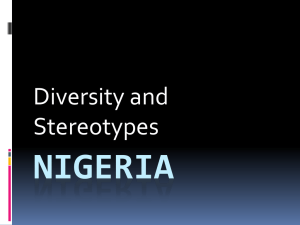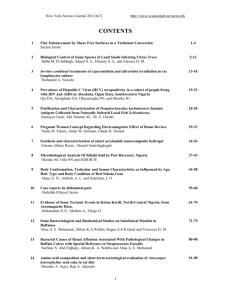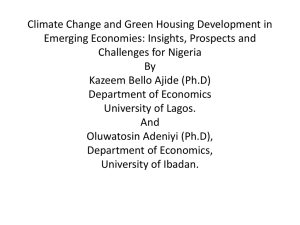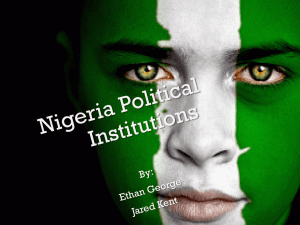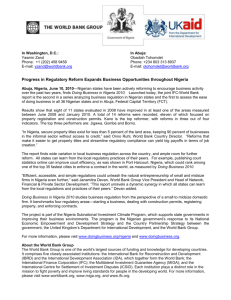ARC-05-5621
advertisement
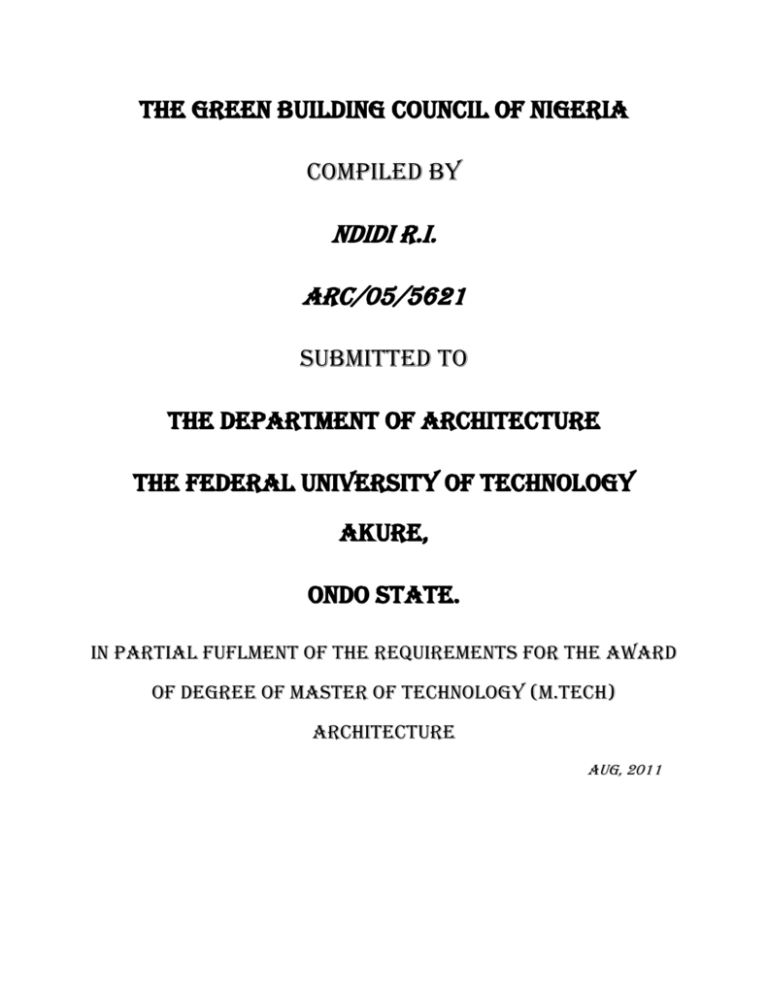
The green building council of nigeria COMPILED BY NDIDI R.I. ARC/05/5621 SUBMITTED TO THE DEPARTMENT OF ARCHITECTURE THE FEDERAL UNIVERSITY OF TECHNOLOGY AKURE, ONDO STATE. IN PARTIAL FUFLMENT OF THE REQUIREMENTS FOR THE AWARD OF DEGREE OF MASTER OF TECHNOLOGY (M.TECH) ARCHITECTURE AUG, 2011 TABLE OF CONTENT TITLE PAGE 1.0 INRODUCTION 1 2.0 THE COUNCIL OF REGISTERED BUILDERS OF NIGERIA 1 (CORBON) 3.0 DEVELOPING A GREEN AGENDA FOR NIGERIA 2 3.1 ENERGY SUPPLY 3 3.2 TRANSPORTATION 3 3.3 WASTE MANAGEMENT 4 3.4 DESIGN AND BUILDING INNOVATION 4 4.0 BUILDING RATING SYSTEMS 5 5.0 CONCLUSION 7 1.0 INTRODUCTION “Environmental sustainability” “global warming” and “green” have become common terms in discussions on the subject matter about the effects of our economic and social activities on the environment. Emerging economies are also starting to appreciate environmental issues, albeit to varying degrees. According to a recent report on the green agenda of African countries, South Africa, Kenya and Ghana top the table in terms of promoting projects with an environmental sustainability focus. Going green” is the phrase referring to corporate and individual action consciously taken to curb the harmful effects on the environment through consumer habits and lifestyles. Recently, attention has been focused on the built environment. “We recognise that the building sector is one of the largest contributors to (green house gas) emissions, with commercial buildings contributing between 30%-40% of these emissions annually” said the GE Real Estate CEO at a forum where the company committed to improving the environmental performance of its substantial commercial real estate portfolio 2.0 THE COUNCIL OF REGISTERED BUILDERS OF NIGERIA The Council of Registered Builders of Nigeria (CORBON) has said that with the approval last August for the establishment of Green Building Council for Nigeria, to enforce the practice of Green Building management in Nigeria. These are part of the measures reeled out by the CORBON Chairman, Prof. Akin Akindoyeni to curb the menace of building collapse and other defects in the industry at the occasion of the council’s 11th investiture and induction of new members in Abuja where 189 persons including the Emir of Bauchi HRH (Bldr) Rilwanu Suleman Adamu were formally absorbed into the circle of registered builders .Before now South Africa is the only African Country with Green Building Council- a concept driven by the United Nations to ensure sustainability of clean, green and safe built environment.. 3.0 DEVELOPING A GREEN AGENDA FOR NIGERIA Nigeria is confronted with several peculiar challenges which make a green agenda appear unattainable. Top of these include the solutions that have been adopted because of the inefficiencies in the energy and transportation systems, as well as waste management. The building industry also has its peculiar handicaps. 3.1 ENERGY SUPPLY It is reported that Nigerians burn an average of 40 million litres of petrol/diesel per day for the private generation of electricity. Keeping the efficient supply of energy in the hands of licensed providers appears to be a long way away, so is seeking alternative clean power (such as from wind, solar and waste). The Nigeria Energy Commission whose mandate includes to “guarantee adequate, sustainable and optimal supply of energy at appropriate cost and in an environmentally responsible manner to the various sectors of the economy, by utilising all viable energy resources in an optimal mix appears incapable of championing initiatives in alternative clean energy. Industry operators can play a significant role in the development and use of clean energy “simple” solutions such as the use of modular solar-powered generating plants (particularly for domestic use) will make a big difference, in a country which is reported to have 60 million petrol/diesel powered generating sets. What appears to be lacking is a concise government agenda, translating into strategies, top of which are the policies and incentives required to encourage private sector participation. Several years ago, the Government of Rwanda entered into a 25 year partnership with a German state for the provision of alternative clean power. The Kigali project is one of several initiatives being undertaken under this arrangement. The solar plant will upon completion generate 325 kilowatt of electricity. The government-led initiative has generated sufficient interest within the private sector, which is expected to play a prominent role in future projects under the partnership. 3.2 TRANSPORTATION The poor state of infrastructure and the lack of impactful investments mean most Nigerian cities lack efficient transportation systems. Other more recent problems such as petrol pricing and carbon dioxide emissions should be forcing governments to consider implementing better public transportation initiatives. Unfortunately, a country whose primary mode of transport (in its major cities) is the motorcycle with capacity for two persons (although known to carry four or five) may not be in a position to discuss environmentally efficient ways to achieving mass transportation. Still, incentives from government can generate private participation, first in basic research and development seeking existing adaptable solutions. Vehicles using clean energy technologies are relatively expensive, a hydrogen powered bus developed in 2009, and whose only emission is water, is priced at us$1.5million.vii however, varieties of cost efficient hybrids have been developed over the past decade and are in use in many developing countries .a growing range of global environment funds, such as the global environment facility (GEF), are available specifically for the funding of sustainable public transport and less polluting energy supplies. It is reported that in Africa, only Tanzania has taken advantage of the GEF. 3.3 WASTE MANAGEMENT There have been very little done by successive governments or relevant agencies with regards to environmentally sustainable waste disposal. Indiscriminate dumping of waste by individuals and government agencies is rife. Only in the past couple of years has the Lagos State Government developed (and is implementing) a waste management strategy. 3.4 DESIGN AND BUILDING INNOVATION Building better communities through environmental innovation should top the agenda of any government and influencing the way this happens, a priority. The government needs to lead by example in this regard, rather than passing laws determining what the private sector can do. Government agencies must incorporate sustainable strategies into their own projects. Policies on greening construction/buildings should be introduced with the government championing implementation. Such policies could include energy and water efficiency, environmental quality of building materials and resources, indoor environmental quality and innovation in design. A certification process such as the Leadership in Energy and Environmental Design (LEED) ratings could be introduced, with attractive incentives for compliance by the private sector. Professionals in the industry must educate themselves and their clients about the benefits of incorporating green initiatives as an upfront investment in construction projects. This is with a view to significantly reduce operating cost over the lifetime of a building, while contributing positively to the environment and the people who use the building. There is sufficient proof to show that “green” sustainable building projects do not have to be cost-prohibitive. There are many cost effective steps that can be taken to make a community a better place to live and work. 4.0 BUILDING RATING SYSTEMS Green building rating systems are an important tool in measuring and evaluating the environmental performance of a building. These rating systems cover a broad range of environmental considerations from the building site selection, design, and construction, to building operations and workspace quality. LEED® (Leadership in Energy & Environmental Design) provides a framework for developing and evaluating high performance green buildings. LEED® Canada is administered by the Canada Green Building Council (CaGBC). LEED is administered by the US Green Building Council in the USA. Built Green Owned and managed by the Built Green™ Society of Canada, BuiltGreen BC offers certification for new single family homes and row homes. Membership in Built Green™ is open to all members of participating Home Builders’ Associations (HBA’s) including builders, renovators, product suppliers or manufacturers, service providers, community developers and municipalities. BOMA best is the leading environmental certification program for commercial buildings. This national program was launched in 2005 by BOMA Canada to address an industry need for realistic standards for energy and environmental performance of existing buildings based on accurate, independently verified information. Today it has evolved from simply identifying key best practices to providing common standards; an array of educational and online assessment tools; independent data audits; and a four-level performance certification program. BOMA Go Green Plus an online assessment tool that measures the environmental performance of commercial buildings. Go Green Plus delivers scoring reports on how a building is performing, as well as providing very specific questions that enable the building manager to look at the components needed to achieve the benchmarks. SBTool Formerly known as GBTool, SBTool is a generic framework for rating the sustainable performance of buildings and projects. It may also be thought of as a toolkit that assists local organizations to develop rating systems. The system handles large projects or single buildings, residential or commercial, new and existing construction, or a mix of the two. Download SBTool from the International Initiative for a Sustainable Built Environment site. Building Research Establishment Environmental Assessment Method (BREEAM), a voluntary rating system developed in the UK, BREEAM Buildings can be used to assess any type of building (new or existing) against a set criteria and provides an overall score which will fall within a band providing either a; PASS, GOOD, VERY GOOD or EXCELLENT rating 5.0 CONCLUSION Nigeria is said to be endowed with an abundance of renewable energy resources. According to the Nigeria Energy Commission, there are a lack of technologies, a dearth of professionals and an absence of appropriate policies and regulations to stimulate demand and attract investors. Under the Kyoto Protocol on climate change, developed countries can offset some of their emissions through renewable energy projects in the developing countries via the Clean Development Mechanism (CDM). It is estimated that projects under the CDM could (over the long-term) generate up to $100 billion worth of funds for developing countries. Unfortunately, Africa’s share of such projects remains low. Of the over 300 projects currently approved, only six are in Africa, none of these is in Nigeria. What would be a practical way forward? The short answer is “take small steps”. Government agencies must lead by example, professionals in the industry need to educate themselves and their clients and commit to introducing environmental sustainability in design and building. Just like rebranding Nigeria, the government needs to embark on environmental initiatives to develop a green consciousness amongst Nigerians.




